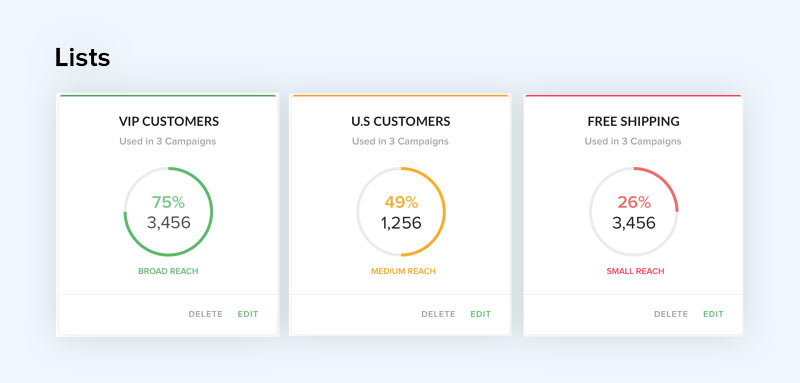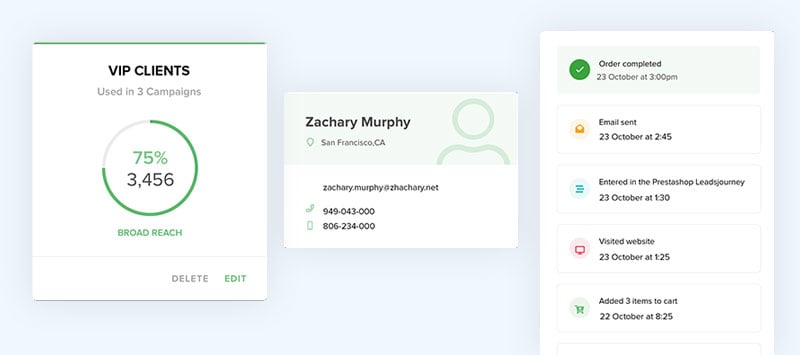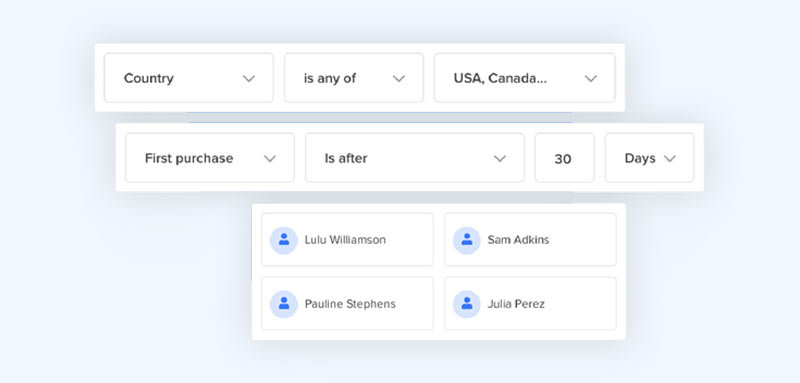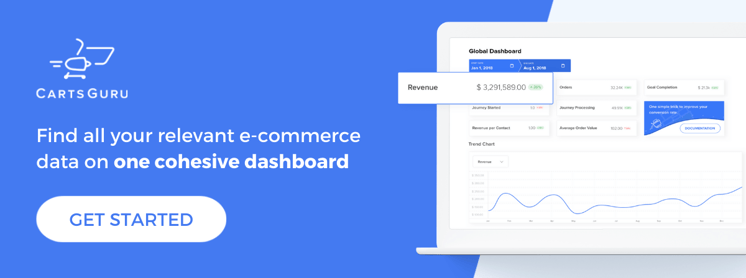
It is essential for ecommerce businesses to understand the way their customers think and act. What values do they hold? How often do they shop? What do they do for a living? And most importantly, what do they want out of an ecommerce shopping experience?
Of course, these aren’t easy questions to answer. But, by exploring the world of customer segmentation, e-merchants can gain clarity and insight into what makes their clients tick. Through the categorization of customers into groups defined by common characteristics, businesses are able to market on a more personalized level - and increase ecommerce sales as a result.
Ready to learn more? Let’s get started.
The benefits of ecommerce customer segmentation
Without customer segmentation, an ecommerce brand can only hope that its marketing efforts resonate with potential clients. Untargeted guesswork is quick and easy, of course, but it doesn’t produce anywhere near the same quality of results as highly targeted messages do.
By segmenting their audience, e-merchants are able to shape their marketing campaigns to catch the attention of specific groups. This comes with a huge range of benefits:

Build better relationships with ecommerce customers
Let’s say an online store sells all-natural cleaning products. Through testing, they may find one marketing message is effective in engaging suburb-dwelling new parents; perhaps it’s a message that conveys the product is safe for the entire family. On the other hand, they might find another message draws in pet owners who live in cities - perhaps something that speaks to how well the products kill odors.
E-commerce customer segmentation empowers the brand to relate better to their customers and make them feel recognized. In turn, it helps to retain these clients for longer.
Bring in new ecommerce clients
E-commerce customer segmentation can also help brands bring in an entirely new audience group interested in their product. When Puma wanted to increase its popularity amongst female consumers back in 2014, for example, the brand partnered with Rihanna who worked as their global ambassador and creative director. A year later, their fourth-quarter sales increased by 17.1%, which the brand says is thanks to the pop star.
Get feedback from specific ecommerce marketing segments
Once brands have a clear understanding of which customer segments buy from them most, they can focus on improving products to address clients’ wants and needs. Ask customers for testimonials and reviews to learn from their experience with your brand. If a furniture brand understands their most profitable clients are condo-owning Millennials, for example, they might focus on designing mid-priced furniture for smaller spaces.
Choose the right communication channel
E-commerce brands reach out to their clients on a range of communication channels. By understanding who their most profitable clients are, brands can gain insight into where their marketing spending really counts. This means brands have the opportunity to target an e-commerce customer segment with a message that resonates most with them on the right channel - whether it be email, SMS, or social media.
The 4 types of ecommerce customer segmentation
When it comes to segmentation, there are four main factors that are most often used to break up and group audiences:
Geographic segmentation
As you might expect, geographic segmentation groups customers based on location, using filters such as country, city, or climate, etc. The all-natural cleaning products brand mentioned at the beginning of this article may market dryer sheets to customers in cold climates who use their dryers regularly, but decide against doing so for customers in warm climates who tend to dry clothes on a rack.
Demographic segmentation
Demographic segmentation is also quite straightforward. It divides customers based on things like gender, income, and age. It can also cover education, nationality, or lifecycle stage - such as whether someone is entering retirement. This can be useful when selling a female-oriented product, or a service for people with a certain level of income.

Behavioral segmentation
This type of segmentation is all about customer actions, and groups customers based on their purchase history and spending habits. For example, the natural cleaning brand may choose to target customers who regularly buy natural hair and skin treatments, since it’s likely that they’re interested in other eco-friendly products or complementary items.
You can target these lists in a number of ways:
- Recommend items that customers in the same segment also bought
- Share exclusive offers on related items via email
- Target highly relevant product ads on social media
- Give a related gift or discount on a certain essential item after a minimum purchase
Psychographic segmentation
Psychographic segmentation separates customers into distinct groups based on their values, interests, lifestyle, priorities, attitudes, and other traits. This might mean marketing to customers who are environmentally conscious, or perhaps those who take public transportation to reduce their carbon footprint.
Some of this information can be gathered quite easily through market research sites, a customer’s previous purchase history, or a listed geographical location. It could also be available on Google Analytics, or analytics found in a brand’s marketing automation platform.
However, in order to really delve deep into certain customer traits, e-merchants need to do more research. You might use automated feedback collection emails, popups, or onsite widgets to learn more about current or potential clients. You can then use this information to develop accurate e-commerce customer segments.
Dynamic versus static contact lists
When it comes to e-commerce marketing and retargeting, brands should be sure to leverage both dynamic and static contact lists.
So what’s the difference? Well, with static lists, the clue is in the name; these email lists don’t change much. They contain important information relevant to a brand’s wider audience and are used for emails containing newsletters, news releases, or as follow-ups after events.
Dynamic lists, on the other hand, are always changing based on customer geographic, demographic, behavioral, and psychographic information. These lists are for nurturing leads and closing sales. And as you can see, both static and dynamic lists are equally important.
5 examples of practical ecommerce customer segments
1. VIP customer list
Create a dynamic list that automatically includes customers who have either spent over a certain amount on your site, have made over a certain number of total purchases, or who purchase regularly.
Once a customer joins the dynamic VIP list, enroll them in an exclusive VIP campaign. The aim of this campaign is to thank these valuable customers for their loyalty and to nurture their business long-term. A VIP campaign should reach out to customers every few weeks with special offers, discounts, and sneak-peaks at new product lines
2. Inactive customer list
Existing customers are an invaluable asset for e-merchants. Acquiring a new customer costs 5x more than retaining a new one, and the success rate of selling to an existing customer is 60-70% compared to just 5-20% for new customers.
Don’t let existing customers become unengaged with your brand. When a certain amount of time passes between purchases, automatically enroll customers in an inactive customer list and send them a win-back campaign.
A win-back campaign includes brand updates, exciting new product releases, and often a special discount to incentivize a purchase and move the customer from inactive to active.

3. Nurturing list
Just because an abandoned cart campaign has run its course, doesn’t mean engagement with the contact should be over. After all, they have shown interest in your brand, and you have their contact details. These are two valuable pieces of information that e-merchants need to take advantage of.
Automatically add all acquired contacts to a nurturing list to keep your brand front-of-mind. Send brand updates, upcoming sales, event information, and new product releases every couple of months to keep them engaged long term.
4. Location-based list
The geographic location of a customer plays a huge role in determining what they want to buy, and what time of year they want to buy it. Divide contacts into northern hemisphere, southern hemisphere, and equatorial regions to keep messaging relevant and to make sure you don’t market a new winter coat to a customer living in balmy Fiji.
Another use for location-based lists is when celebrating a nation or region-specific shopping holiday. A great example of this is Boxing Day, the biggest online sales day of the year for customers in the UK, Australia, and New Zealand, but unheard of in most other parts of the world.
5. New customer list
Start new customer relationships in the best way possible and show you’re a brand that cares. As soon as a visitor makes their first purchase, automatically enroll them in a new customer list, then send a welcome campaign.
A welcome campaign is an opportunity to showcase your branding, tone of voice, and to give customers a means to reach out to your brand. E-merchants who open a dialogue and build trust from the first transaction stand a much better chance of retaining customers long term.
There’s no doubt about it: customer segmentation is an incredibly important pillar in today’s marketing world. Customer segmentation gives brands everywhere crucial insights into what customers really want and need. In turn, brands can build loyal customer bases, reach new clients, and see your e-commerce sales go through the roof.


